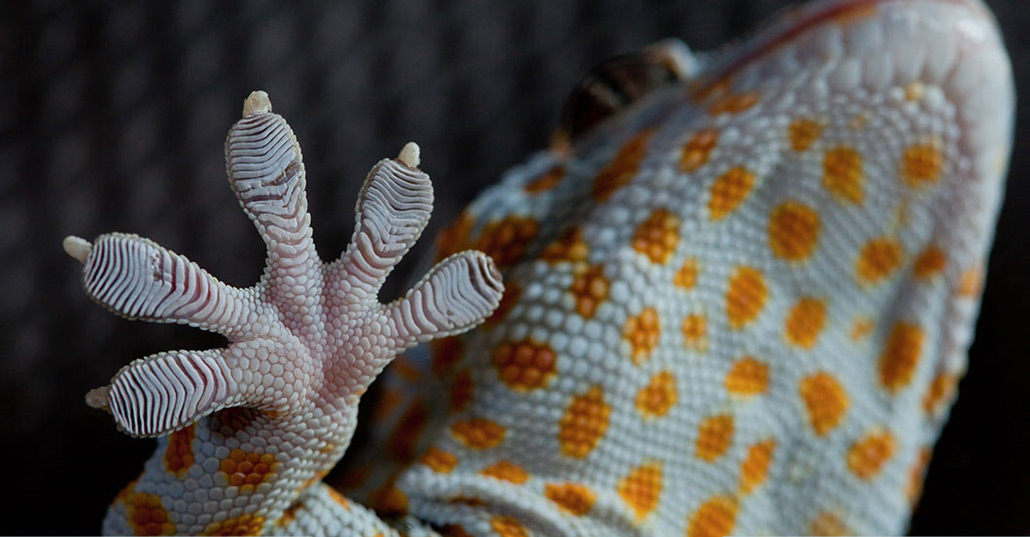The Invention
The ability of geckos to climb vertical and overhanging walls has long fascinated scientists and laypeople alike. Geckos possess a complex set of specializations for adhering to smooth surfaces, which include stiff tendons that insert into their toepads. On their toepads, geckos possess millions of minute hairs called setae that act as a soft substrate that can conform to surfaces. Scientists have studied geckos for decades but the principles underlying gecko adhesion remained elusive until now.
Inspired by Geckos
At different locations on the campus of UMass Amherst, two scientists were independently analyzing gecko adhesion with different aims. Biologist Duncan Irschick had been studying gecko climbing and clinging adhesion for over 20 years. Polymer scientist Alfred Crosby had been working on polymer adhesion for almost as long and was interested in creating a novel adhesive material that would embody gecko attributes.
In 2009, with a grant from DARPA, an agency of the U.S. Department of Defense, Crosby's research team was working on synthetic adhesives built on a simple yet revolutionary principle: They believed that if adhesives were made with stiff fabrics, adhesive force could increase dramatically. Most commercial adhesives are soft and gooey, yet the Crosby group believed that this compliant nature was a limitation.
Go Geck Team
Curious if their ideas about stiffness were upheld in geckos, the Crosby team reached out to Duncan Irschick. Working together, they discovered, as hypothesized, that geckos possessed stiff tendons attached to their toepads, which acted much like the stiff fabric adhesives that the Crosby lab had been developing.
Geckskin™ was formally revealed to the world in February of 2012, with the publication of an article in the journal Advanced Materials. Crosby, Irschick, doctoral candidate Mike Bartlett, and the rest of the research team had unlocked the simple yet elegant gecko secret for adhesion and created a novel technology that is revolutionizing how we attach objects together.







 Mike Bartlett, PhD graduate, the Crosby Research Group, Polymer Science & Engineering: Mike is an inventor of Geckskin™ and is the first author on the seminal Geckskin™ paper that appeared in the February 2012 issue of Advanced Materials that introduced Geckskin™ to the world. He has published several papers in high impact journals on the science behind Geckskin™ and has won several awards for his research.
Mike Bartlett, PhD graduate, the Crosby Research Group, Polymer Science & Engineering: Mike is an inventor of Geckskin™ and is the first author on the seminal Geckskin™ paper that appeared in the February 2012 issue of Advanced Materials that introduced Geckskin™ to the world. He has published several papers in high impact journals on the science behind Geckskin™ and has won several awards for his research. Daniel R. King, doctoral candidate, the Crosby Research Group, Polymer Science & Engineering: Dan is an inventor of Geckskin™ and continues to innovate and design new Geckskin™ adhesives. His current research focuses on how shape and different elastomer formulations influence adhesion. Dan was a coauthor on the seminal Geckskin™ paper that appeared in the February 2012 issue of Advanced Materials and he will be lead author on several upcoming publications regarding Geckskin™. He has received several awards and much recognition for his research accomplishments on Geckskin™.
Daniel R. King, doctoral candidate, the Crosby Research Group, Polymer Science & Engineering: Dan is an inventor of Geckskin™ and continues to innovate and design new Geckskin™ adhesives. His current research focuses on how shape and different elastomer formulations influence adhesion. Dan was a coauthor on the seminal Geckskin™ paper that appeared in the February 2012 issue of Advanced Materials and he will be lead author on several upcoming publications regarding Geckskin™. He has received several awards and much recognition for his research accomplishments on Geckskin™. Michael Imburgia, doctoral candidate, the Crosby Research Group, Polymer Science & Engineering: Michael has been an active researcher examining the role of compliance in both geckos and in synthetic devices and how it influences adhesion on different surfaces.
Michael Imburgia, doctoral candidate, the Crosby Research Group, Polymer Science & Engineering: Michael has been an active researcher examining the role of compliance in both geckos and in synthetic devices and how it influences adhesion on different surfaces. Andrew Croll, former postdoctoral researcher, the Crosby Research Group, Polymer Science & Engineering: Andrew is an inventor of Geckskin™ and was instrumental in developing the guiding scaling theory behind the design of Geckskin™.
Andrew Croll, former postdoctoral researcher, the Crosby Research Group, Polymer Science & Engineering: Andrew is an inventor of Geckskin™ and was instrumental in developing the guiding scaling theory behind the design of Geckskin™. Beth Paret, former undergraduate researcher, Crosby Research Group, Polymer Science & Engineering: As an undergraduate majoring in art history, Beth was instrumental in applying her sewing skills to integrate different elements of Geckskin™, which was crucial for developing the first usable prototypes. She also provided invaluable graphic design skills to illustrate the skin–tendon–bone connections that were a critical finding in the seminal Geckskin™ paper that appeared in the February 2012 issue of Advanced Materials.
Beth Paret, former undergraduate researcher, Crosby Research Group, Polymer Science & Engineering: As an undergraduate majoring in art history, Beth was instrumental in applying her sewing skills to integrate different elements of Geckskin™, which was crucial for developing the first usable prototypes. She also provided invaluable graphic design skills to illustrate the skin–tendon–bone connections that were a critical finding in the seminal Geckskin™ paper that appeared in the February 2012 issue of Advanced Materials.